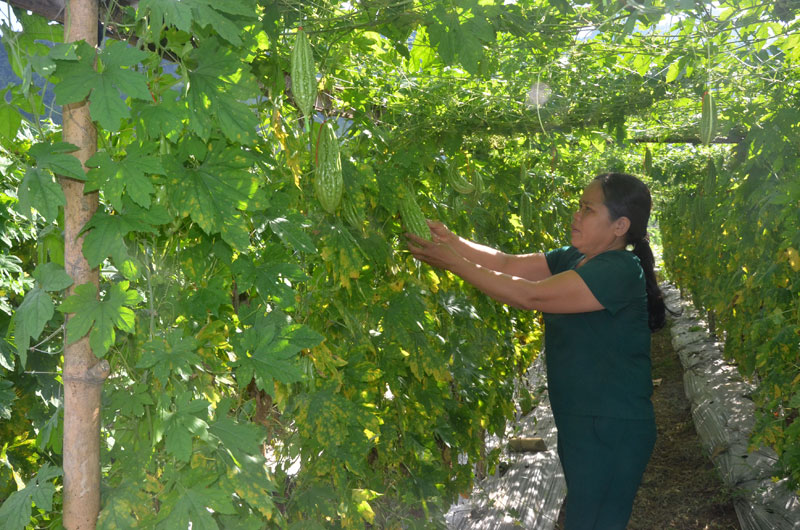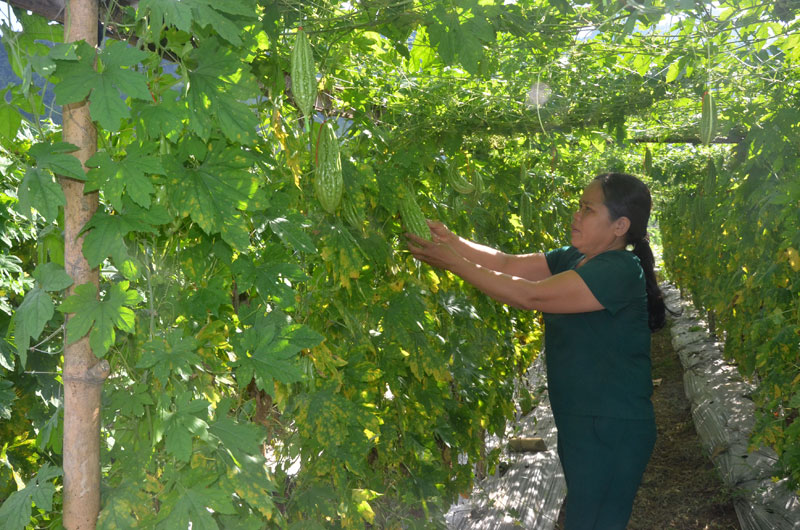
(HBO) -. In the past years, Lo Son commune (Tan Lac) has successfully converted many ineffective land areas into high value tree species.

Many households in Lo Son commune (Tan Lac)
overcame step by step from poverty thanks to the cultivation of high economic
value crops.
Thanks to that change, the area of growing
grapefruit of Lo Son commune has increased from more than 1 hectare planted in
2014 to 45.5 hectares up to now. Grapefruit is found in most of the hamlets,
mainly focused in villages of Cung, Tan
Son, Doi, Doi Moi and Be. From the effective achievements, at present, Lo Son
continues to direct the village to propagate and mobilize people for actively
converting the structure of plants, bringing the high economic value trees such
as grapefruits, logans, etc. into planting orientation to replace inefficient
plants.
Together with Resolution No 10-NQ / HU, the
implementation of Resolution No 12-NQ / HU of Tan Lac District Committee on
"bringing annual crops into inefficient land of rice cultivation" in
Lo Son has achieved some remarkable results. Accordingly, the whole commune has
205 hectares of rice cultivation land, the area of paddy rice is about 100
hectares, the water crop is about 105 hectares, the average productivity is
from 45 to 50 quintals / hectare, in which, the amount of land which lacks
water and produces inefficiently accounts for about 40%.
From the original 250 hectares of paddy land,
up to now, the area of paddy land in the commune has decreased to about 100
hectares. The whole area of inefficient rice land was shifted to high economic
value trees such as bitter melons, pumpkins, melons, sugarcanes and vegetables,
which are produced in the direction of safety, etc. Therefore, the value on the
same area of cultivation reached from 150 to 180 million in a hectare per one
crop, many times higher than the rice cultivation.
Ms. Bui Thi Thuy from Nghia 1 village, Lo Son
commune said: Previously, my family had 2,000m2 of rice cultivation. After
being propagated and mobilized by the commune, village, my family converted
1,000 m2 to grow bitter melon for seeds and various vegetables. In fact, the
cultivation of crops gives the value 4-5 times higher than that of rice.
like Ms. Thuy's family, Ms. Bui Thi Hoa's
family in Chieng village has converted most of their rice land into annual
crops. Thanks to that, from being a poor household, Ms. Hoa's family has
stepped up to escape poverty and stabilize their life.
According to data from the Hoa Binh Provincial Party Committee, the industrial production index for the first six months of 2025 is estimated to have increased by 20% compared to the same period last year. This marks the highest year-on-year growth rate for this period since 2020.
In the first six months of 2025, Hoa Binh province’s export turnover was estimated at 1.145 billion USD, marking an 18.11% increase compared to the same period in 2024. Import turnover was estimated at $ 804 million, a 17.15% increase, which helped the province maintain a positive trade balance.
The lives of the ethnic minority farmers in Tan Lac district have gradually improved thanks to the new directions in agricultural production. This is a testament to the collective strength fostered through the professional associations and groups implemented by various levels of the district’s Farmers’ Union.
With the motto the "product quality comes first,” after nearly one year of establishment and operation, Muong village’s Clean Food Agricultural and Commercial Cooperative, located in Cau Hamlet, Hung Son Commune (Kim Boi district), has launched reputable, high-quality agricultural products to the market that are well-received by consumers. The products such as Muong village’s pork sausage, salt-cured chicken, and salt-cured pork hocks have gradually carved out a place in the market and they are on the path to obtaining the OCOP certification.
In the past, the phrase "bumper harvest, rock-bottom prices" was a familiar refrain for Vietnamese farmers engaged in fragmented, small-scale agriculture. But today, a new spirit is emerging across rural areas of Hoa Binh province - one of collaboration, organisation, and collective economic models that provide a stable foundation for production.
Maintaining growing area codes and packing facility codes in accordance with regulations is a mandatory requirement for agricultural products to be eligible for export. Recently, the Department of Agriculture and Environment of Hoa Binh province has intensified technical supervision of designated farming areas and packing facilities to safeguard the "green passport" that enables its products to access international markets.



